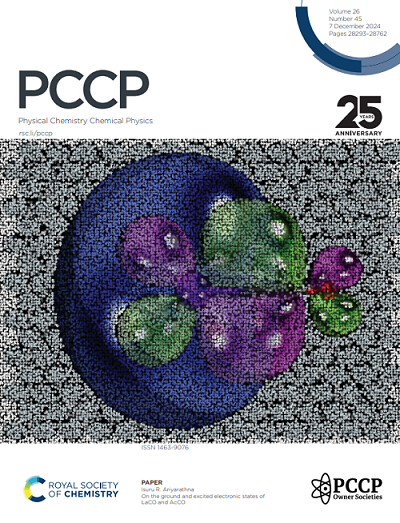Molecular conformational effects on the overall rate constant and the branching ratios of the n-heptane + OH reaction: An ab initio and variational transition state theory study
IF 2.9
3区 化学
Q3 CHEMISTRY, PHYSICAL
引用次数: 0
Abstract
The oxidation of fuels by hydroxyl radical (OH) is a crucial initiation step in both combustion and atmospheric processes. In the present work, we explore the site-specific hydrogen atom abstraction reactions by OH from n-heptane through high level ab initio and sophisticated kinetic calculations. Rate constants for each of the four distinct abstraction sites were computed, for the first time, over a wide temperature range (200-3000 K) and using multistructural torsional variational transition state theory (MS-T-VTST) with small curvature tunneling (SCT) corrections. Optimized geometries, vibrational frequencies and minimum energy paths (MEPs) were determined using the M06-2X/aug-cc-pVTZ level of theory, with single-point energy refinements performed at the CCSD(T)/aug-cc-pVTZ level of theory to refine the energy of the optimized stationary points whose energy is up to 1 kcal mol-1 of their respective global minimum conformer. Our findings reveal that the overall rate constants obtained from our site-specific calculations align closely with experimental data, with a maximum deviation factor (kexp/ktheory) of 1.5 at 1000 K. More importantly, we provide branching ratios that are based on first-principle calculations, identifying the secondary site neighboring the primary site as the dominant abstraction channel—data not previously reported in the literature, thereby adding value to our kinetic study. Moreover, we demonstrate that, as long as multi-structural torsional anhamonicity effects are implemented, appropriate density functional methods with large enough basis sets can yield rate constants that are comparable to those from much more computationally demaning levels of theory that are based on wave function methods. The demonstrated protocol, in which we have also tested the effect of different energy cuttoffs for the computationally intensive single-point energy refinements, effectively handles large and conformationally complex chemical systems, offering a reliable framework for future investigations in this field involving similar chemical systems whose kinetics is barely known or simply based on estimations.求助全文
约1分钟内获得全文
求助全文
来源期刊

Physical Chemistry Chemical Physics
化学-物理:原子、分子和化学物理
CiteScore
5.50
自引率
9.10%
发文量
2675
审稿时长
2.0 months
期刊介绍:
Physical Chemistry Chemical Physics (PCCP) is an international journal co-owned by 19 physical chemistry and physics societies from around the world. This journal publishes original, cutting-edge research in physical chemistry, chemical physics and biophysical chemistry. To be suitable for publication in PCCP, articles must include significant innovation and/or insight into physical chemistry; this is the most important criterion that reviewers and Editors will judge against when evaluating submissions.
The journal has a broad scope and welcomes contributions spanning experiment, theory, computation and data science. Topical coverage includes spectroscopy, dynamics, kinetics, statistical mechanics, thermodynamics, electrochemistry, catalysis, surface science, quantum mechanics, quantum computing and machine learning. Interdisciplinary research areas such as polymers and soft matter, materials, nanoscience, energy, surfaces/interfaces, and biophysical chemistry are welcomed if they demonstrate significant innovation and/or insight into physical chemistry. Joined experimental/theoretical studies are particularly appreciated when complementary and based on up-to-date approaches.
 求助内容:
求助内容: 应助结果提醒方式:
应助结果提醒方式:


